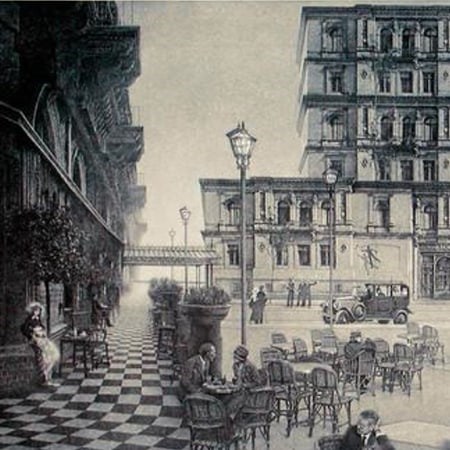jumping for joyce, francis kyle gallery, london – review
This exhilarating exhibition explores the legacy of modernism from an oblique angle
In 1922, after a Stravinsky soirée, Proust and Joyce shared a taxi their only meeting. Joyce was half blind and Proust couldn’t breathe; when the Irish writer opened the window to smoke, the Frenchman thought he was trying to kill him. Joyce, who had just published Ulysses, complained that Proust talked only of duchesses whereas he preferred chambermaids.
All this and much more Man Ray photographing both writers; Duchamp experimenting with his “Large Glass”; a girl, maybe Joyce’s/Homer’s Nausicaa, watching herself being watched in a mirror; the impenetrable façade of a looming building resonant of Kafka, who began The Castle in 1922 is condensed in Peter Milton’s giant etching “The Ministry”. Playing with layers, transparencies, reflections, fragments, collapsed narratives, mythological figures, in a stunningly textured print which yields vista after vista, abundant detail within a perfectly considered composition, Milton gives visual form to our continuing vexed, intoxicated relationship with the modernist moment.
“The Ministry” and a second Milton masterpiece about light, painting, film, “Tracking Shot”, made using digital media and focused on a young and old Joyce meeting in Milan’s Galleria Vittorio Emanuele II, are highlights of an upbeat, offbeat summer show for which Francis Kyle invited 20 gallery artists to respond to Joyce. Like Milton, Alain Senez in his triptych of shadowy/spotlit interiors “Dublin”, “Trieste”, “Paris” marvellously interrogates both the nature of image making and the workings of memory. Gerald Mynott, a landscapist at onceromantic and modern, detached, turns his attention to the Liffey and the Tuileries and to evocative interiors the contrasting bars of Sweny’s in Dublin and Paris’s Brasserie Julien. I enjoyed too John Fisher’s “Caffe San Marco, Trieste” and the shrill colours, strange light and laconic juxtaposition of cartoonish and art historical motifs in Jon Wealleans’ “Portrait of the Artist”, and his parody of interiority “Nora Barnacle/Molly Bloom, Daydream III” comic notes in an exhilarating exhibition that explores modernism’s legacy from an oblique, provocative angle.

